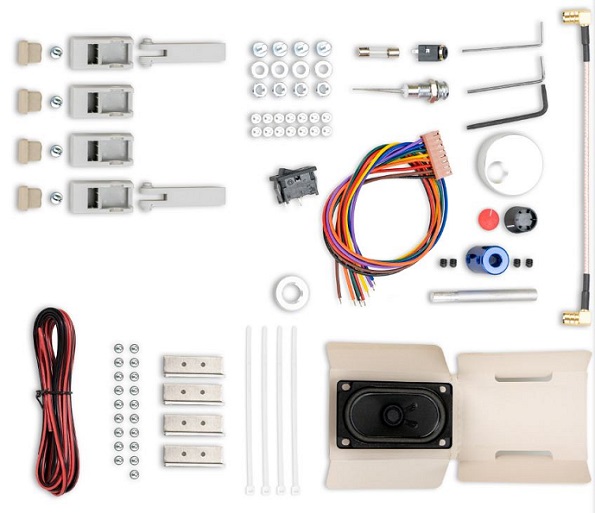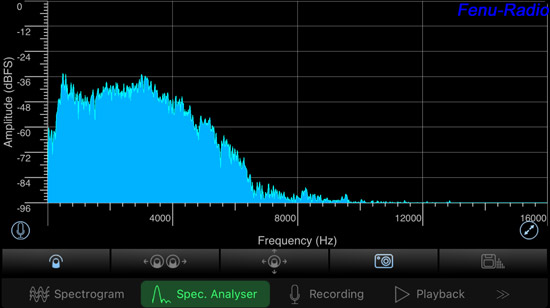|



Stampfl Stressless AM-Receiver
From Heinz
Stampfl's workshop comes a device that caused a lot of discussion
and misunderstanding before it went on sale. The “Stampfl Stressless
AM receiver”.
When prospective buyers look at this receiver, the “must have”
function is immediately activated in their minds. The white
lacquered housing and the colorful display heighten expectations and
make it stand out from the gray-black crowd. If you step closer to
the device, the knowledgeable eye will recognize that it is a pure
AM radio. Why no SSB, is the first thought. In the flood of today's
all-rounder devices, the Stressless stands out with a downgrade.
What is the reason for this?
The philosophy of the “Stressless” is reception of pure AM modulated
radio stations on long wave, medium wave and short wave. Switch on,
tune in, lean back and enjoy. No long rummaging through the bands.
The target group of the “Stressless” is the classic program
listener.
.jpg)
The most
important key data of the Stressless
-- Operating mode: AM
-- Frequency range: 100 kHz - 30 MHz
-- Principle: Double super, IF 21.4 MHz, 455 kHz
-- AM bandwidth filter LT455 HTW = 6Khz
-- Automatic switching preselector with 1 low-pass filter
and 4 band-pass filters
-- Frequency display: 5” TFT LCD display, 480 x 272 pixels,
resistive touchscreen
-- 50 frequency memories
-- Signal strength display: Single LED
-- Intermodulation IM3: +20 dB
-- Sensitivity: 100 kHz - 30 MHz, 12 dB S/N at -101 dBm,
mod. 1 kHz, 80 %
-- Antenna connection: BNC socket
-- Power supply: 11 - 15 V-DC, 360 mA
-- Dimensions: Width 305 mm, height 120 mm, depth 185 mm
-- Weight: 1.7 kg
-- Local oscillator: SI5351, 30 MHz TCXO
Scope of delivery:
-- Stressless kit |
The “Stressless” kit
The AM receiver is supplied as a kit. All circuit boards are
pre-assembled, eliminating the need for time-consuming soldering and
adjustment work. The receiver only needs to be screwed together and
a few wires soldered. The manufacturer writes in the instructions
that this kit is aimed at amateurs and beginners. Nevertheless, a
certain degree of dexterity and understanding of the technology
should be present. The assembly time is approx. 1.5 to 2 hours.
 |
 |
The housing and the circuit boards
The white lacquered housing shells are made of aluminum and are
a perfect fit. The front panel and rear panel of the “Stressless”
are made of circuit board material. The prefabricated circuit boards
are of good quality and neatly finished. The trained eye will notice
a few things. Firstly, there is the 5-stage preselector. This offers
good antenna compatibility and largely protects against out-of-band
interference. The other is the optical tuning encoder from Copal.
This high-quality encoder guarantees an extremely long service life.
Nowadays, the majority of encoders used are mechanical, which stop
working properly after a short time. The well-known JRC NRD-525/535
shortwave receivers had the same Copal encoders installed. Next is
the 5” TFT touchscreen. This is of very good quality and by no means
a cheap part. Then there is the loudspeaker from Visaton. This
quality loudspeaker promises good sound. You can tell from details
like this that the manufacturer has not cut corners.
.jpg)
The
smart exterior
Let's take a look at the stylish receiver in its assembled and
ready-to-use state. With its white lacquered housing and colorful
display, it is literally crying out to be touched! But before we
indulge in some stress-free listening, let's take a closer look at
the receiver. There is no beauty without flaws! This is also the
case with the “Stressless”. The housing screws selected by the
manufacturer are not attractive and do not do the device justice.
The screws on the front panel in particular are bulky and
inappropriate in terms of color. The tuning knob is made of aluminum,
but with a diameter of 32 mm it is unfortunately a little small and
not very easy to grip. The small finger recess is not deep enough.
In addition, the tuning knob protrudes too far from the front panel.
The volume knob would fit in better with the concept if it were also
aluminium and the same color. Apart from that, the Stressless makes
a solid impression.
.jpg)
The display
The central point of the receiver is the 5” touchscreen display. All
receiver functions are set there. After switching on, the welcome
screen appears with the setup button. Pressing this immediately
takes you to the simply structured settings menu.
Possible settings:
-- Reset function. Device is reset to original settings. Memory is
retained.
-- Encoder pulses 50 or 100 pulses per revolution of the tuning knob.
-- Tuning after exiting memory mode: Last set memory or last set VFO
frequency.
-- Color settings of the display fields, function buttons and
frequency display.
Below: A few
examples of the color settings. Other color combinations can be set.
.jpg)
Working with the Stressless
Operating the Stressless is easy and quick to learn. If you tap on
the frequency display, you can enter the desired frequency in KHz
directly. Tapping on “Rundfunk” below the frequency display takes
you to the frequency band input screen. Here you can tap directly on
the desired band. The Stressless has two VFOs. This is practical if
you want to compare a station on the parallel frequency. If you want
to adjust the frequency in 1 MHz steps, press the arrow buttons
above the Memo button. The frequency is then adjusted using the
tuning knob.
If the touchscreen is not touched, the display switches back to the
main display after 5 seconds.
The experienced program listener knows his favourite frequencies and
stores them in the 50 frequency memories. Once this is done, you can
use the tuning knob in memo mode to conveniently tune through the
memories without interrupting the audio.
The range of tuning steps caused some surprise. What is the point of
the 100Hz & 2.5KHz tuning steps on an AM receiver? The assumption is
that the software comes from another Stampfl receiver and has been
modified for the Stressless.
.jpg)
Tuning the frequency with the small
tuning knob is a little tough. If the tuning knob were slightly
larger, turning it would be easier. The volume of the Stressless can
be turned up very loudly without the audio clattering. The volume
control should be operated carefully, as the volume is already very
high in the lower control range. The highlight of the receiver front
is the great display. It responds very well to touch. The inputs are
well accepted even with a gentle touch. There is also the red
“Field” LED. This starts to light up at around S9. For transmitters
that come in at S9+20dB, the LED lights up fully. It has no real use.
The switchable loudspeaker with the switch on the front is practical.
The Stressless is overdrive-proof! Even with the vertically operated
MegaDipol MD300DX, which delivers really fat signals, the Stressless
remained calm.
Audio playback
No test without comparison! I compared the Stressless with my Icom
IC-R75, which has Kiwa modifications built in. The R75 sounds much
brighter than the original due to the modification in the audio
path. The AGC has also been significantly improved.
In direct comparison with the built-in loudspeaker, the Stressless
sounds mercilessly bright and leaves the R75 behind in terms of
sound. With medium and strong stations, the Stressless shines with
its crystal-clear audio reproduction, which unfortunately has little
bass. If the signal level of the transmitter falls below a certain
value, the AGC of the Stressless no longer regulates. The
transmitter becomes quiet and the audio sometimes has a bright
background noise. If you listen with headphones or connect stereo
active speakers to the headphone output, the Stressless produces a
kind of pseudo-stereo sound. It seems to be a kind of 2-channel
mono. In any case, the audio gets a certain width. This effect is
very pleasant with medium and strong stations. If the level
decreases, this effect is more of a disadvantage. If you don't like
this effect, you can use a jack stereo/mono adapter to make the
audio sound mono.
The Stressless
offers an audio frequency response up to approx. 14KHz, the R75
stops at approx. 7.5KHz. These recordings were made with a
microphone directly on the device speaker. No antenna, only the
noise generated by the receiver.
Audio frequency response
Stressless
 |
Audio frequency response
Icom IC-R75 Kiwa Mod.
 |
Reception comparisons
Second 0 - 10: Stampfl Stressless
Second 10 - 20: Icom IC-R75 Kiwa Mod.
Chaine 3 -
252khz
 |
R. Tunis
Chaine Int. - 963khz
 |
Darc Radio -
6070khz
 |
HCJB Voice of
Andes - 7365khz
 |
TWR Africa -
9500khz
 |
Voice of Vietnam-RUS -
9730khz
 |
Media
Broadcast - 13660khz
 |
Radio Vatican
- 13830khz
 |
R. Exterior
Espana - 15520khz
 |
R. Algerienne
- 17700khz
 |
Radio
Tamazuj - 21485khz

|
Conclusion:
The Stampfl Stressless AM receiver is an exotic product! For the
pure program listener without DX ambitions, it is a practical
receiver of very good quality. The Stressless masters the main
discipline, the reception of medium and strong AM stations, without
any problems and sounds pleasantly bright, unfortunately with too
little bass range. If the signals fall below a certain level, the
signals become quiet. This seems to be caused by the AGC. Thanks to
the preselection, no clipping effects could be detected. The
Stressless, which is available as a kit, has its good points but
also a not-so-good point. The reception of somewhat weaker stations
should be a little better.
Source of supply:
Stampfl Elektronik
posted:
25.05.2024



|
.jpg)




.jpg)

.jpg)
.jpg)

.jpg)

.jpg)
.jpg)
.jpg)
.jpg)

.jpg)
.jpg)

